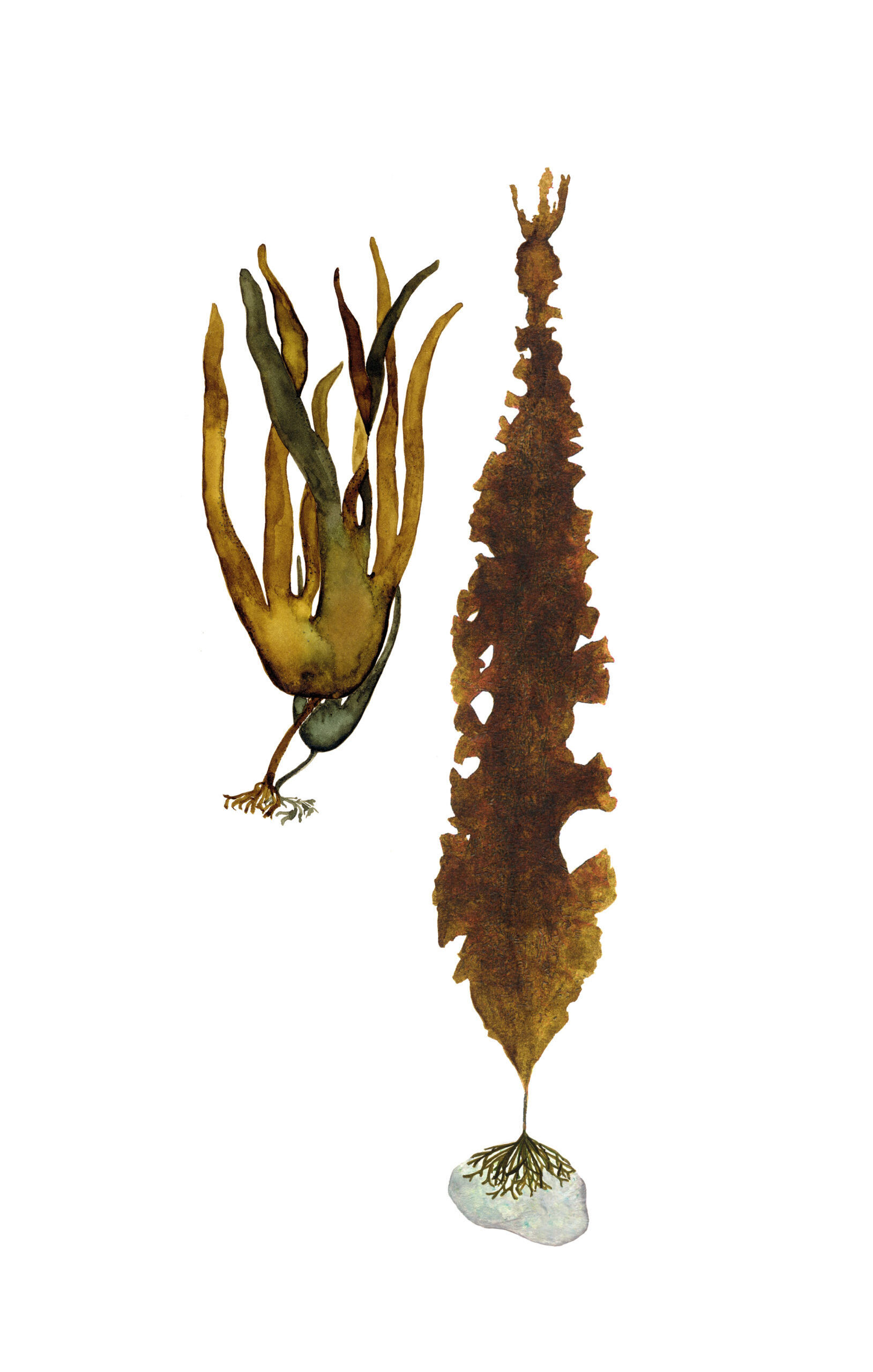
Miek Zwamborn, Stone Away. pencil, inks made with lichen and watercolour on paper, diverse sizes, 2021.
31 attempts to draw the same stone - found in her garden - during the month of January in 2021.
On Becoming Terranascient
Glenn A. Albrecht, Earth Emotions: New Words for a New World (Cornell University Press, 2019)
Miek Zwamborn, Onderling: Langs de kustlijn van Mull (Van Oorschot, 2023)
Taco Hidde Bakker
28 aug. 2023 • 3 min

Miek Zwamborn, Oarweed and Sugar kelp, Bistre on paper, 20 cm x 30 cm, 2019.
After an afternoon’s beachcombing I see the silhouettes of the algae spread on the sand projected on the inside of my eyelids at night before I fall asleep: green and red, brighter than in reality. The seaweed floats freely inside my head, tumbling like bright costumed acrobats in brain fluid.
By happenstance, I retrieved the following lines from my book diaries, written in late spring 2020, at a time when I began to read sci-fi (rather late in life). I still stand by their message, which wonderfully matches two books I’ve been reading side by side recently during a stay on the Wadden island of Terschelling, located on the southern rim of Europe’s vast northern spaces:
Those who now write and in no way incorporate the ecological crisis in their stories and (word) games, may rightly be called escapist. Interspecies communication and ways of making ecologies resonate and speak is of life-saving importance, when it comes to the long-term survival of humanity as embedded within the broader lifeworld. Where in sci-fi does one find animals and plants (besides planets)?
The two books I have just read, Glenn A. Albrecht’s Earth Emotions: New Words for a New World and Miek Zwamborn’s Onderling: Langs de kustlijn van Mull (the title could be translated as ‘Reciprocal: Along Mull’s Coastline’), are not science fiction, even though for dis-eased urban dwellers, disconnected from nature, this may unfortunately be the case. Both authors express intense love for the localities they inhabit, observe, and describe, one in his native Australia, the other in what she has made her home, the Scottish island of Mull, since 2016.
Albrecht, whom I recently witnessed as an inspiring speaker at the 10th Futurological Symposium at the endemic artist’s village of Ruigoord (situated in the hellscape of Amsterdam’s extensive distribution centres and harbour facilities), explicitly draws the vital connection between the health of ecosystems and the physical and mental well-being of a person. For Albrecht, the cancerous era of the Anthropocene should be replaced sooner rather than later with what he names the Symbiocene, which ‘will be characterized by human intelligence and praxis that replicate the symbiotic and mutually reinforcing life-reproducing forms and processes found in living systems.’ The Symbiocene means a complete reintegration of the human body, psyche, and culture with the rest of life (on all scales). As a transdisciplinary farmosopher, Albrecht is keen on inventing new (and necessary) words for the English language that express all sorts of negative and positive ‘earth emotions’, the best known of which so far has been solastalgia (a variant of nostalgia, expressing the longing for the return of a home that has been taken away by earth-destroying forces beyond one’s own control).
Zwamborn, a native Dutch writer and artist in Scotland, in her wonderful cabinet of experiences and curiosities that is Onderling (which collects essays, (translated) poems, diaries, letters, photographs, and drawings), also recognizes language as pivotal for a healthy relationship to the land (and water) one inhabits, when she writes that ‘more than ever do I want to be permeated with the landscape and to study the origins of the local language. Literally and figuratively. On the island I wish to extend my writing and to find new words as a sailor (answering the wind and the currents), beach comber (collecting that which washes ashore), and fisher (sorting that which arrives in the nets).’
Whereas Albrecht primarily focuses on renewed symbiotic relationships between humans and the rest of life (and the geochemical cycles on which it depends) with a philosophical mindset, Zwamborn shows how the Symbiocene could be lived in practice and reflected on artistically, based on principles of recycling and creativity, including a sensitivity to how local language can be a force for earth creation (terranascia in Albrecht’s glossary) rather than earth destruction (terraphthora).
Note to the reader. This article is part of Trigger’s 2023 ‘Summer Read’ series. We invited writers, researchers, photographers and curators to share what is currently occupying their mind through one publication they have been (re)reading during summer. What matters to them is now being recast as a challenge for today. Highly personal entries to a diversity of publications (photobooks, studies, monography, essay, historical research) lead us – readers of these readers – to reorient our gaze on (the history of) images and photography.